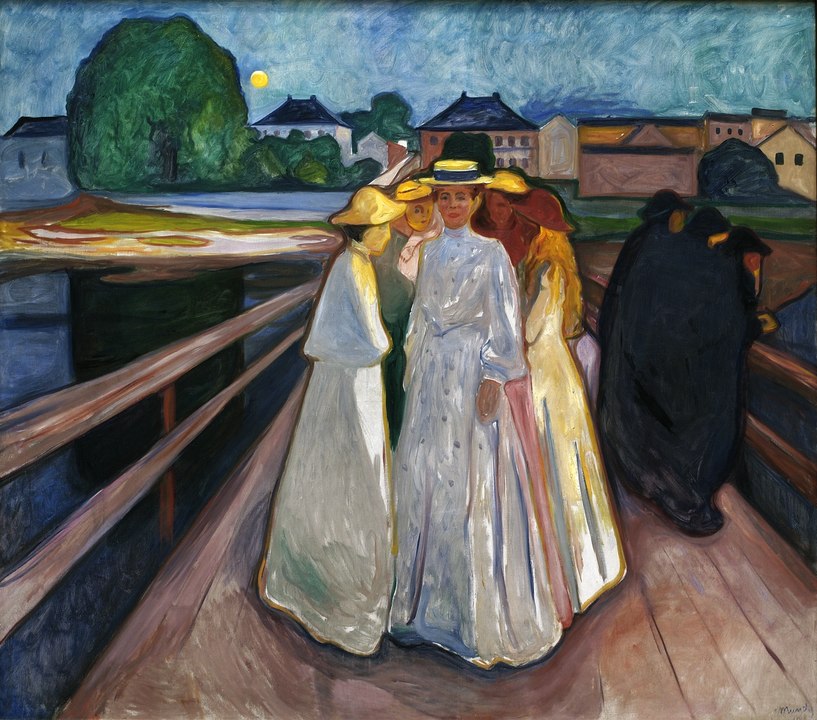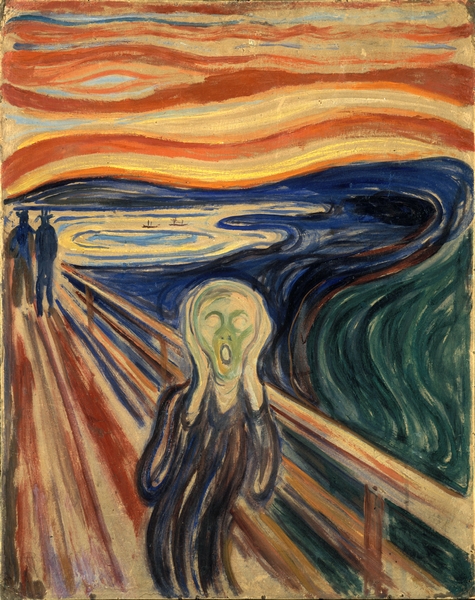Edvard Munch
The Dance of Life is displayed on the wall of Cromer Carpets, The Croft, opposite the TIC.
The Scream is displayed at Poppyland Brewery on West Street
Tracey Emin / Edvard Munch at the Royal Academy 2020: The exhibition features more than 25 of Emin’s works including paintings, some of which will be on display for the first time, as well neons and sculpture. These works, which explore the loneliness of the soul, have been chosen by Emin to sit alongside a carefully considered selection of 18 oils and watercolours drawn from MUNCH’s rich collection and archives in Oslo, Norway.

Edvard Munch
Throughout his life Munch shows through his work – paintings, drawings, prints and sculptures – an obsession with the cycle of life, love, and death, and where he fits into that cycle.
Born in Norway in 1863, he was the second of six children. His mother died of consumption when he was just 5 years old. His older sister also died of consumption when Munch was 14. As a child, Munch was not well himself, and often spent time at home convalescing.
Although, his father wanted him to train to be an engineer, Munch found expression for sickness and the tragic loss of life in his art. He was determined to study painting and his early work shows consistent themes of sickness and death.
Munch spent time in both the art worlds of Paris and Berlin during the 1890s where he started studies for the Freize of Life themes. In Paris, he sold work and was prosperous enough to by a property in Norway.
In 1898 Munch bought a summer house in Asgardstrand, Norway. He also began a relationship with Tulla Larsen, and they travelled together through Italy . When he returned from this journey, he began painting the final painting in his Freize of Life series, The Dance of Life in 1899.
For more detail about Edvard Munich’s life see wikipedia.org/wiki/Edvard_Munch
The Dance of Life
1899, 126cm x 191cm, oil on canvas
What do you notice about the main figures in this painting?
Look at the female figures, could they be the same woman?
What do you think Munch is trying to say about ‘life’ in this painting?
And why do you think he painted life as a ‘dance’?
For more information on the Dance of Life visit: edvardmunch.org

National Gallery (Norway)

In this programme made for the BBC, Tracey Emin talks about how Edvard Munch’s life and work has influenced her own work. He was the first artist to take ‘selfies’, for example. Munch was never able to commit to a long term relationship, had a turbulent personal love life, as well as problems with alcohol dependence.
Emin’s sculpture ‘Mother’ is due to be placed outside the new Munch Museum in Oslo in Spring 2021.
“The Frieze of Life” themes recur throughout Munch’s work but he especially focused on them in the mid-1890s. In sketches, paintings, pastels and prints, he tapped the depths of his feelings to examine his major motifs: the stages of life, the femme fatale, the hopelessness of love, anxiety, infidelity, jealousy, sexual humiliation, and separation in life and death. These themes are expressed in paintings such as The Sick Child (1885), Love and Pain (retitled Vampire; 1893–94), Ashes (1894), and The Bridge.

His financial situation improved considerably and in 1897, Munch bought himself a summer house facing the fjords of Kristiania (Oslo), a small fisherman’s cabin built in the late 18th century, at Åsgårdstrand. He called this the “Happy House” and returned here almost every summer for the next 20 years. It was this place he missed when he was abroad and when he felt depressed and exhausted. “To walk in Åsgårdstrand is like walking among my paintings—I get so inspired to paint when I am here”.

As his fame and wealth grew, his emotional state remained insecure. He briefly considered marriage, but could not commit himself. A breakdown in 1908 forced him to give up heavy drinking, and he was cheered by his increasing acceptance by the people of Kristiania (Oslo) and exposure in the city’s museums. His later years were spent working in peace and privacy. Although his works were banned in Nazi Germany, most of them survived World War II, securing him a legacy.

The Scream (1910)
The Scream exists in four versions: two pastels (1893 and 1895) and two paintings (1893 and 1910). There are also several lithographs. The 1893 version was stolen from the National Gallery in Oslo in 1994 and recovered. The 1910 painting was stolen in 2004 from The Munch Museum in Oslo, but recovered in 2006 with limited damage.
The Scream is Munch’s most famous work, and one of the most recognizable paintings in all art. It has been widely interpreted as representing the universal anxiety of modern man. Painted with broad bands of garish colour and highly simplified forms, and employing a high viewpoint, it reduces the agonized figure to a garbed skull in the throes of an emotional crisis.
With this painting, Munch met his stated goal of “the study of the soul, that is to say the study of my own self”. Munch wrote of how the painting came to be: “I was walking down the road with two friends when the sun set; suddenly, the sky turned as red as blood. I stopped and leaned against the fence, feeling unspeakably tired. Tongues of fire and blood stretched over the bluish black fjord. My friends went on walking, while I lagged behind, shivering with fear. Then I heard the enormous, infinite scream of nature.” He later described the personal anguish behind the painting, “for several years I was almost mad… You know my picture, ‘The Scream?’ I was stretched to the limit—nature was screaming in my blood… After that I gave up hope ever of being able to love again.”

(Norwegian: Skrik), 1893, National Gallery and Munch Museum, Oslo, Norway
